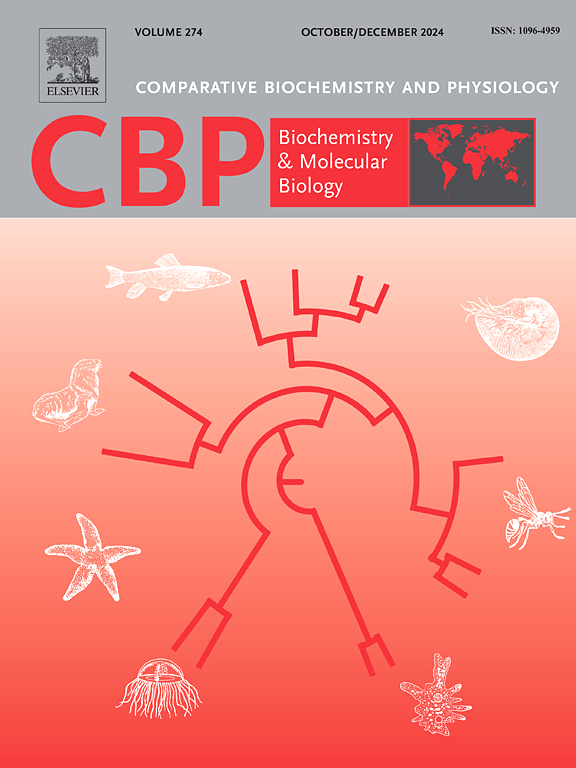Soluble expression and functional characterization of multi-subunit hemoglobins from the blood clam, Tegillarca granosa
IF 1.8
3区 生物学
Q4 BIOCHEMISTRY & MOLECULAR BIOLOGY
Comparative Biochemistry and Physiology B-Biochemistry & Molecular Biology
Pub Date : 2025-07-09
DOI:10.1016/j.cbpb.2025.111125
引用次数: 0
Abstract
The Escherichia coli expression system, combined with site-directed mutagenesis, is a powerful tool for investigating the structure-function relationship of hemoglobin (Hb). However, producing biologically active recombinant hemoglobin (rHb) from invertebrates, especially in multimeric forms, remains difficult. Here, we describe the recombinant expression, purification, and characterization of homodimeric rHbI and heterotetrameric rHbII from the blood clam Tegillarca granosa. Optimization of expression conditions demonstrated that high yields (65.4–135.6 g/L) of soluble T. granosa rHbs could be achieved using the JM109(DE3) strain with 15 °C induction, 0.25 mM isopropyl β-D-thiogalactoside (IPTG) levels, and codon optimization. Circular dichroism and ultraviolet-visible spectroscopy verified that purified rHbs exhibited a secondary structure similar to that of native Hbs (nHbs) and preserved their diverse ligand-binding capacities. Oxygen-binding assays further showed that the oxygen affinity of rHbs was comparable to that of nHbs. Nitrite reduction assays revealed that T. granosa nHbs exhibited weak nitrite reductase activity (0.049–0.116 M−1 s−1 at 25 °C), generally lower than that of vertebrate globins. However, rHbs, particularly rHbI, displayed substantially higher reduction rate constants (0.147–4.589 M−1 s−1 at 25 °C) than nHbs, possibly due to differences in structural conformation or the N-terminal tag carried by rHbs. Overall, the recombinant expression and purification method established in this study provides a valuable framework for future research on the structure-function relationships of T. granosa Hb and invertebrate Hbs more broadly.

泥蚶多亚基血红蛋白的可溶性表达及功能表征
大肠杆菌表达系统,结合定点诱变,是研究血红蛋白(Hb)结构-功能关系的有力工具。然而,从无脊椎动物中生产具有生物活性的重组血红蛋白(rHb),特别是以多聚体形式,仍然很困难。在这里,我们描述了从泥蚶中重组表达、纯化和表征同二聚体和异四聚体的rHbII。优化表达条件表明,JM109(DE3)菌株在15°C诱导、0.25 mM异丙基β- d -硫代半乳糖苷(IPTG)水平和密码子优化条件下,可获得高产量(65.4-135.6 g/L)的可溶性大叶黄菌。圆二色性和紫外可见光谱验证了纯化的rHbs具有与天然Hbs (nHbs)相似的二级结构,并保留了其不同的配体结合能力。氧结合实验进一步表明,rHbs的氧亲和力与nHbs相当。亚硝酸盐还原实验表明,T. granosa nHbs具有较弱的亚硝酸盐还原酶活性(25°C时为0.049 ~ 0.116 M−1 s−1),普遍低于脊椎动物珠蛋白。然而,rHbs,特别是rHbI,表现出明显高于nHbs的还原速率常数(25°C时为0.147-4.589 M−1 s−1),这可能是由于rHbs结构构象的差异或其携带的n端标签。综上所述,本研究建立的重组表达和纯化方法为今后更广泛地研究巨噬菌Hb和无脊椎动物Hb的结构-功能关系提供了有价值的框架。
本文章由计算机程序翻译,如有差异,请以英文原文为准。
求助全文
约1分钟内获得全文
求助全文
来源期刊
CiteScore
4.60
自引率
4.50%
发文量
77
审稿时长
22 days
期刊介绍:
Comparative Biochemistry & Physiology (CBP) publishes papers in comparative, environmental and evolutionary physiology.
Part B: Biochemical and Molecular Biology (CBPB), focuses on biochemical physiology, primarily bioenergetics/energy metabolism, cell biology, cellular stress responses, enzymology, intermediary metabolism, macromolecular structure and function, gene regulation, evolutionary genetics. Most studies focus on biochemical or molecular analyses that have clear ramifications for physiological processes.

 求助内容:
求助内容: 应助结果提醒方式:
应助结果提醒方式:


